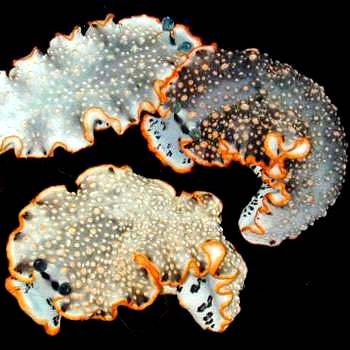
Dermatobranchus ornatus
(Bergh, 1874)
Order: NUDIBRANCHIA
Suborder: ARMININA
Family: Arminidae
DISTRIBUTION
Tropical Indo-West Pacific.
PHOTO
Seragaki, Okinawa, 4 August, 2000. Depth: 56m
Lengths: 60mm, 62mm, 80mm. Photo: Bob Bolland.
A relatively large species of Dermatobranchus usually characterised by the often flat-topped orange tubercles on the mantle, and the orange border to the mantle and oral veil. As ilustrated here in Bob Bolland's photo, colour is variable and tubercles sometimes lack any colouration. In other specimens the tubercles are large and form raised orange rings.
See message below.
Reference:
• Bergh, L.S.R. (1873). Malacologische Untersuchungen. In: C.G. Semper, Reisen im Archipel der Philippinen, Wissenschaftliche Resultate. Band 2, Heft 5: 205-246, Pls. 25-31.
Rudman, W.B., 2000 (August 6) Dermatobranchus ornatus (Bergh, 1874). [In] Sea Slug Forum. Australian Museum, Sydney. Available from http://www.seaslugforum.net/find/dermorna
Related messages
Re:Dermatobranchus ornatus from Thailand, colour variation
February 10, 2009
From: Marcel Tanke
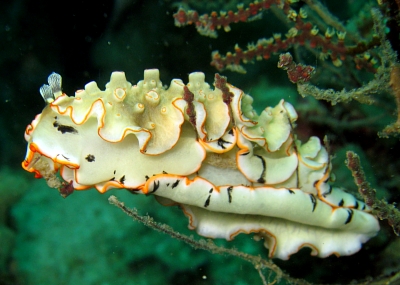
Concerning message #9066:
Hi Bill,
A record of Dermatobranchus ornatus from Thailand with a light green mantle on which the orange crater rings are clearly visible. It is sitting (feeding?) on something I cannot identify. It is not the gorgonian soft coral behind it.
The lower photo shows triangular black marks on the front of the rhinophore stalks.
Locality: Dive site Bida Nok, 15 meter, Thailand, Andaman Sea, 25 January 2009, sandy area. Length: 7 cm. Photographer: Marcel Tanke.
Best regards,
Marcel
marceltanke@cs.com
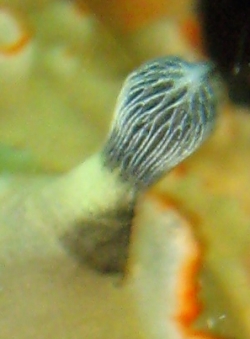
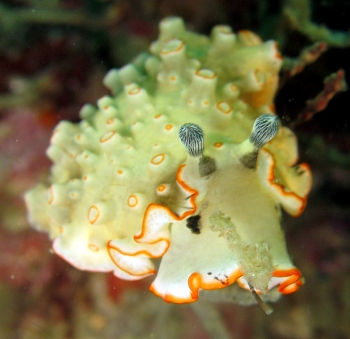

Dear Marcel,
I think from earlier messages we can be pretty sure that this species feeds on gorgonian soft-corals. Looking at your photos I think the animal is sitting on a branch of the gorgonian on which all the living tissue has been eaten off and we are left with just the skeletal framework.
I have also included a close-up showing how the rhinophore leaflets in arminids are arranged vertically, rather than the dorid method of arranging them horizontally
Best wishes,
Bill Rudman
Dermatobranchus ornatus - Feeding & mantle glands
April 8, 2008
From: Gaetan White
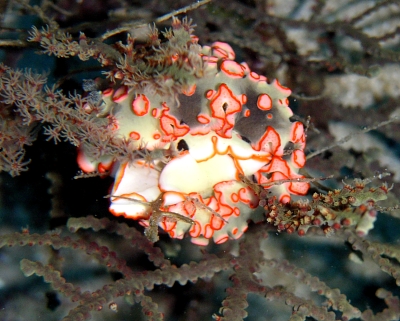
Dear Bill
I cannot imagine how I (and many adults and school kids whom i have introduced the Forum to, especially in remote asian localities) could thank you for your constant work, and the top educational level of info and exchanges.
Whilst searching for previously seen (twice the previous day) shovelnose ray accompanied by a juvenile (Rhinobatus (djiddensis, sp.) Sven Jakubith and myself grabbed a few pics of this sole Dermatobranchus ornatus. It seemed well intent on staying enravelled on the coral (what is it?) and totally stripping it of its surface and polyps. Originally I thought it was Maiazoon orsaki [flatworm], so did not bore you with that, but "Sea Slug Forum" curiosity made me contact Sven to see if he had better pics (definitely visible rhinopores). What intrigued me in the first place was the unusual orange border around its foot! In the middle photo one can clearly see some (chemical) cells around the underneath edge of the mantle. Please correct my layman's terminology.
Locality: Elephant head, 20 m., Thailand, Similan, 23 january 2007 sun rise, Large sandy slope between boulders. Length: 100 mm. Photographer: Gaetan WHITE and Sven JAKUBITH.
Thank you again,
Gaetan.
gaetan.white@wanadoo.fr

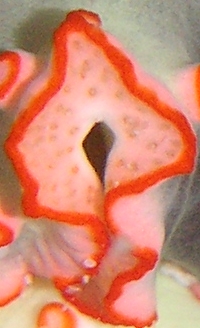
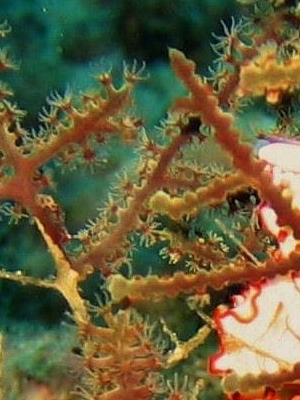
ear Gaetan,
I'm glad you find the Forum valuable. As your contribution illustrates, 'science' gets quite a lot of valuable new information from questions such as yours.
As you will see from earlier messages to the Forum, it seems pretty certain that D. ornatus feeds on gorgonian soft corals. Your photos and observations certainly add to that idea, as the 'coral' in your photos is a gorgonian. There is also quite a lot of evidence to show that soft corals produce an array of nasty, distasteful chemicals which are useful in defending them from predation. We also know that some molluscs which feed on soft corals, such as the egg cowries, and the aeolid Phyllodesmium longicirrum, re-use some of the soft coral's molecules for their own defence by storing them in parts of their bodies. This makes your observation of possible glands under the mantle edge particularly interesting as such glands are often not visible when the animal is collected and preserved.
Last year a paper was published by a joint group from Italy and China (Zhang et al, 2006) reporting a number of possible dietary metabolites in Dermatobranchus ornatus. They linked these metabolites with similar compounds in a gorgonian, Muricella sp. from the same locality, and suggested that the nudibranch was transforming and bio-accumulating some useful dietary metabolites from the gorgonian into selected body parts as defensive substances.
Your 'glands' could well be where the Dermatobranchus is storing these metabolites. Thanks for this very interesting observation, which I am sure will be followed up by the Italian research group.
-
Zhang, W., Gavagnin, M., Guo, Y-W., Mollo, E. & Cimino, G. (2006) Chemical Studies on the South China Sea Nudibranch Dermatobranchus ornatus and Its Suggested Prey Gorgonian Muricella sp. Chinese Journal of Organic Chemistry, 26 (12): 1667-1672
Best wishes,
Bill Rudman
Dermatobranchus ornatus from Malaysia
September 19, 2007
From: Eugene Yeo

Hi Bill,
Ii capture this image of nudibranch in Palau Aur in Malaysia and i'm unable to identify it. could you please identify it for me?
Locality: Palau Aur, Malaysia, Indo Pacific, 19 May, 2007. Photographer: Eugene Yeo.
Thanks.
Eugene Yeo
eyeo@mail.une.edu
Yeo, E., 2007 (Sep 19) Dermatobranchus ornatus from Malaysia. [Message in] Sea Slug Forum. Australian Museum, Sydney. Available from http://www.seaslugforum.net/find/20733Dear Eugene,
This is Dermatobranchus ornatus. Have a look at the Fact Sheet and earlier messages for information on its biology
Best wishes,
Bill Rudman
Dermatobranchus ornatus from Oman
March 30, 2007
From: Brian Mayes
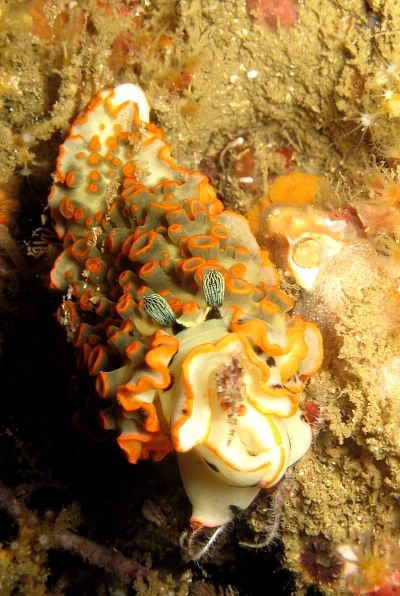
Dear Bill,
Would you be interested in these photos of Dermatobranchus ornatus from Oman. Despite it's size I nearly went right by it, since it looked like a piece of soft coral. There could some clues here as to what it feeds on.
Locality: "Wall Street", Bandar Khairan, Muscat, 21 metres, Oman, Gulf of Oman, 04 March 2007, Silty reef with soft corals. Length: 60mm. Photographer: Brian Mayes.
Best Regards
Brian Mayes
brian@mayescai.freeserve.co.uk
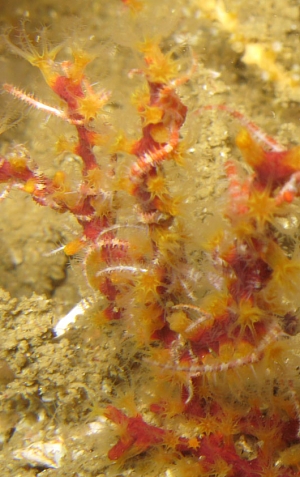
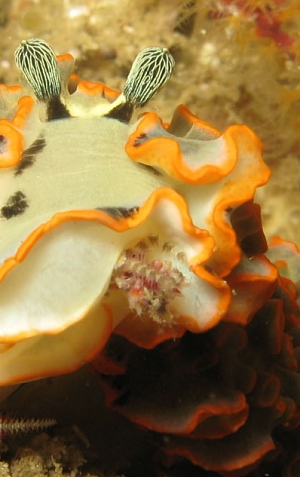
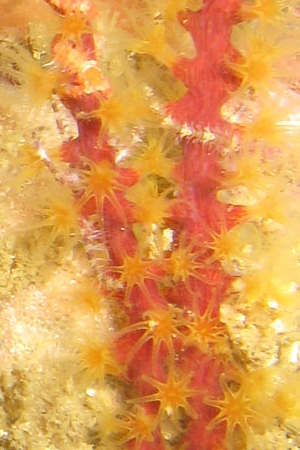
Dear Brian,
This animal certainly resembles a colony of some soft coral. I was quite startled to see the ophiuroid [brittle star] in its mouth, because species of Dermatobranchus normally feed on alcyonacean soft corals. However when I looked at the soft coral in your photos I saw that many of the colonies had the same species of brittle star entangled around the softcoral stalks. This is probably a species of the brittle star genus Ophiothrix, which has a number of species like this with banded arms, and they are often found in association with soft corals. Soft corals are very difficult to indentify just from photos, but I would say this one is the food of your Dermatobranchus - I would say the brittle star in its mouth could be compared with a caterpillar in the salad.
Best wishes,
Bill Rudman
Dermatobranchus ornatus ? from East Timor
April 12, 2006
From: Nick Hobgood
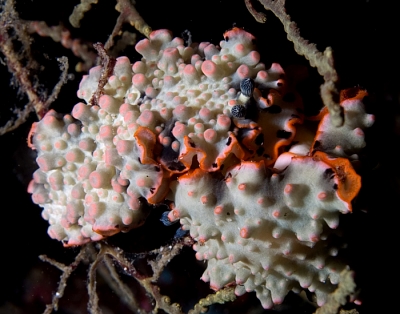
Dear Bill,
These two individuals come closest to Dermatobranchus ornatus from the samples on the forum but not quite. Can you please confirm ?
Locality: Beach, 12 meters, East Timor, Banda Sea, 08 April 2006, Near shore. Length: 30mm. Photographer: Nick Hobgood.
Nick Hobgood
nick@congo-pages.org
Hobgood, N., 2006 (Apr 12) Dermatobranchus ornatus ? from East Timor. [Message in] Sea Slug Forum. Australian Museum, Sydney. Available from http://www.seaslugforum.net/find/16279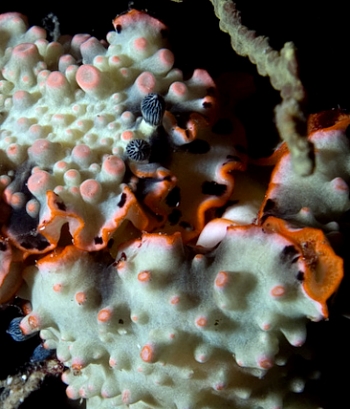
Dear Nick,
Yes this is Dermatobranchus ornatus. It is one of the few species of the genus in which the mantle is lacking longituninal ridges. I hadn't realised until know just how similar in colour and shape this species is to a soft-coral colony. Each of the tubercles could be mistaken for a half extended soft-coral polyp.
Best wishes,
Bill Rudman
Dermatobranchus ornatus from Thailand
February 3, 2003
From: Herb Ko

Please help with ID.
Location: Similan Islands, Thailand
Dive site: Elephant Head Rock
Date and Time: 25 Dec 2002 9am
Depth: ~ 70 feet
Found on sand near hard coral. I only managed one good shot before it went behind the corals.
Herb Ko
uwphoto@herbko.net
Ko, H., 2003 (Feb 3) Dermatobranchus ornatus from Thailand. [Message in] Sea Slug Forum. Australian Museum, Sydney. Available from http://www.seaslugforum.net/find/9066Dear Herb,
This spectacular animal is Dermatobranchus ornatus. It probably feeds on soft corals but we still have a lot to learn about it.
Best wishes,
Bill Rudman
Re: Dermatobranchus ornatus from Japan
August 6, 2001
From: Nishina Masayoshi
Dear Dr.Rudman,
Re your question. As far as I know, the color of D. ornatus does not vary much here. Generally the colour in the image I sent is the normal color at Hachijo and Sagami Bay. The main features of the pattern are:
Dorsal color is beige white with a black or dark brown stain over the body. Rhinophores are brilliant blue. Rounded orange spots scattered over the body with orange colour band on the mantle.
I am not sure that whether there is any other color variation. But I've never seen other color variation here.
Best Regards,
Nishina Masayoshi
nishina@hpe15.wips.co.jp
Nishina, M., 2001 (Aug 6) Re: Dermatobranchus ornatus from Japan. [Message in] Sea Slug Forum. Australian Museum, Sydney. Available from http://www.seaslugforum.net/find/4999Thanks Nishina,
I asked about the colour because in the other photos on the Forum the animals appear a much more drab colour with a dirty brownish background colour and quite dull orange markings. I was wondering whether their colour was affected by their food or perhaps their size.
Best wishes,
Bill Rudman.
Dermatobranchus ornatus from Sagami Bay
August 2, 2001
From: Nishina Masayoshi
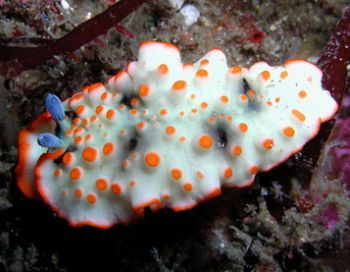
Dear Dr.Rudman,
Here is a photo of Dermatobranchus ornatus that Chikako took on 7th July, 2001 at Enoura beach, Sagami Bay, Japan.
Depth: 12m
Size: 50mm
Comment: Common here
Nishina Masayoshi
nishina@hpe15.wips.co.jp
Nishina, M., 2001 (Aug 2) Dermatobranchus ornatus from Sagami Bay. [Message in] Sea Slug Forum. Australian Museum, Sydney. Available from http://www.seaslugforum.net/find/4972Dear Nishina & Chikako,
This is a very brightly coloured specimen compared with others I have seen, and which we already have on the Forum. Are your specimens always so brightly coloured?
Best wishes,
Bill Rudman
Dermatobranchus ornatus & possible prey
September 5, 2000
From: Nerida Wilson


Bill,
In response to an earlier question about the prey items of Dermatobranchus ornatus, I thought I would send in this picture, taken in the Dampier Archipelago, Western Australia, on 8 August 2000. The dive was during the day, on a beautiful sponge and sea-whip garden, at around 12m. We came upon this nudibranch struggling in earnest to grip onto the coral. Although no conclusive feeding could be seen, the observation may be of some interest.
Nerida Wilson
nwilson@zen.uq.edu.au
Wilson, N., 2000 (Sep 5) Dermatobranchus ornatus & possible prey. [Message in] Sea Slug Forum. Australian Museum, Sydney. Available from http://www.seaslugforum.net/find/2966Thanks Nerida,
A gorgonian soft-coral is certainly an interesting possibility. Your animal also shows the raised orange-rimmed craters I described in an earlier message.
Best wishes,
Bill Rudman.
Feeding in Dermatobranchus ornatus
August 28, 2000
From: Narongpon Sittithaweepat
Dear Bill
I want to know what Dermatobranchus ornatus feeds on? Is it soft coral or coral
Thank you
Narongpon Sittithaweepat
ning@talaythai.com
Sittithaweepat, N., 2000 (Aug 28) Feeding in Dermatobranchus ornatus . [Message in] Sea Slug Forum. Australian Museum, Sydney. Available from http://www.seaslugforum.net/find/2933Dear Narongpon,
We don't know much about the biology of species of Dermatobranchus but most of the small species we know of feed on soft corals [see Dermatobranchus sp. 1.]
I have seen a photo of Dermatobranchus ornatus on what looks like a soft coral but I can't be certain. My guess is that it will probably eat a softcoral but we need some evidence. Photos or sightings of feeding would be welcome in the Forum, as they are for all Sea Slugs.
Best wishes,
Bill Rudman.
Dermatobranchus ornatus from Okinawa
August 8, 2000
From: Bob Bolland

Hi Bill:
Here's a JPEG of three Dermatobranchus. Quite remarkably, they were found together in a tight ball (feeding, mating?); I initally thought they were a solitary sea squirt. I was making an ascent from a complex dive (deep, poor visibility, strong current) and unfortunately I had no time to observe if the animals were associated with any particular prey, and I was forced to make a quick scoop. The area was one of mixed sand, coral rubble and a large patch of Caulerpa sp.
Data:
RFB # 3804-A, -B, -C
Seragaki, Okinawa
4 August, 2000
Depth: 56m
Length: 60mm, 62mm, 80mm
This is the first time I've seen this attractive arminian here and just thought I'd add the image to the Forum to show some of its variation.
Cheers,
Bob.
bollandr@rapid-link.ne.jp
Bolland, R.F., 2000 (Aug 8) Dermatobranchus ornatus from Okinawa. [Message in] Sea Slug Forum. Australian Museum, Sydney. Available from http://www.seaslugforum.net/find/2852Thanks Bob,
It's Dermatobranchus ornatus, which is one of the biggest species of Dermatobranchus. You have certainly covered most of the background colour variation, but I think I have some photos of specimens in which the orange tubercles formed quite large crater-like rings. I'll try and find them.
Best wishes,
Bill Rudman.
